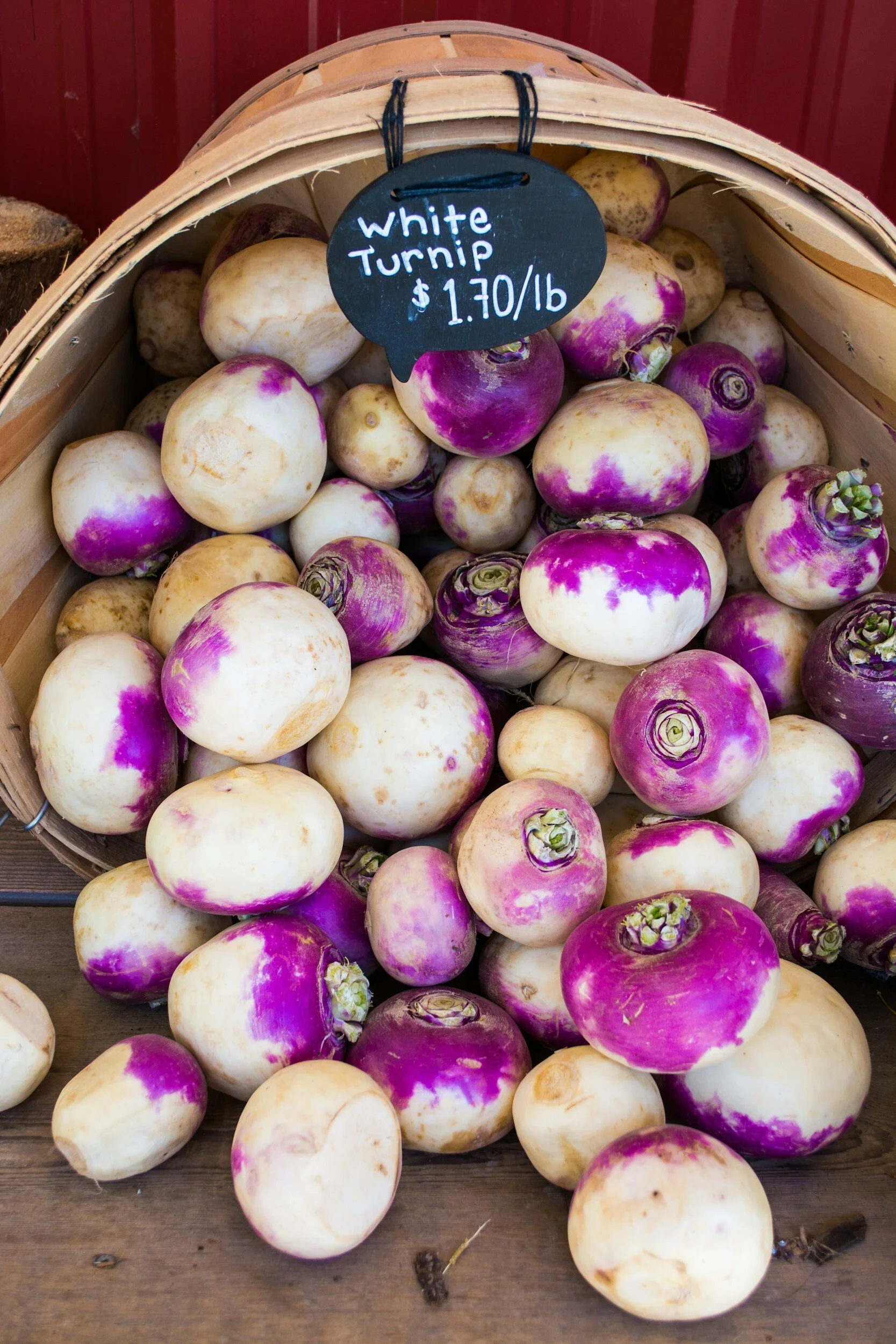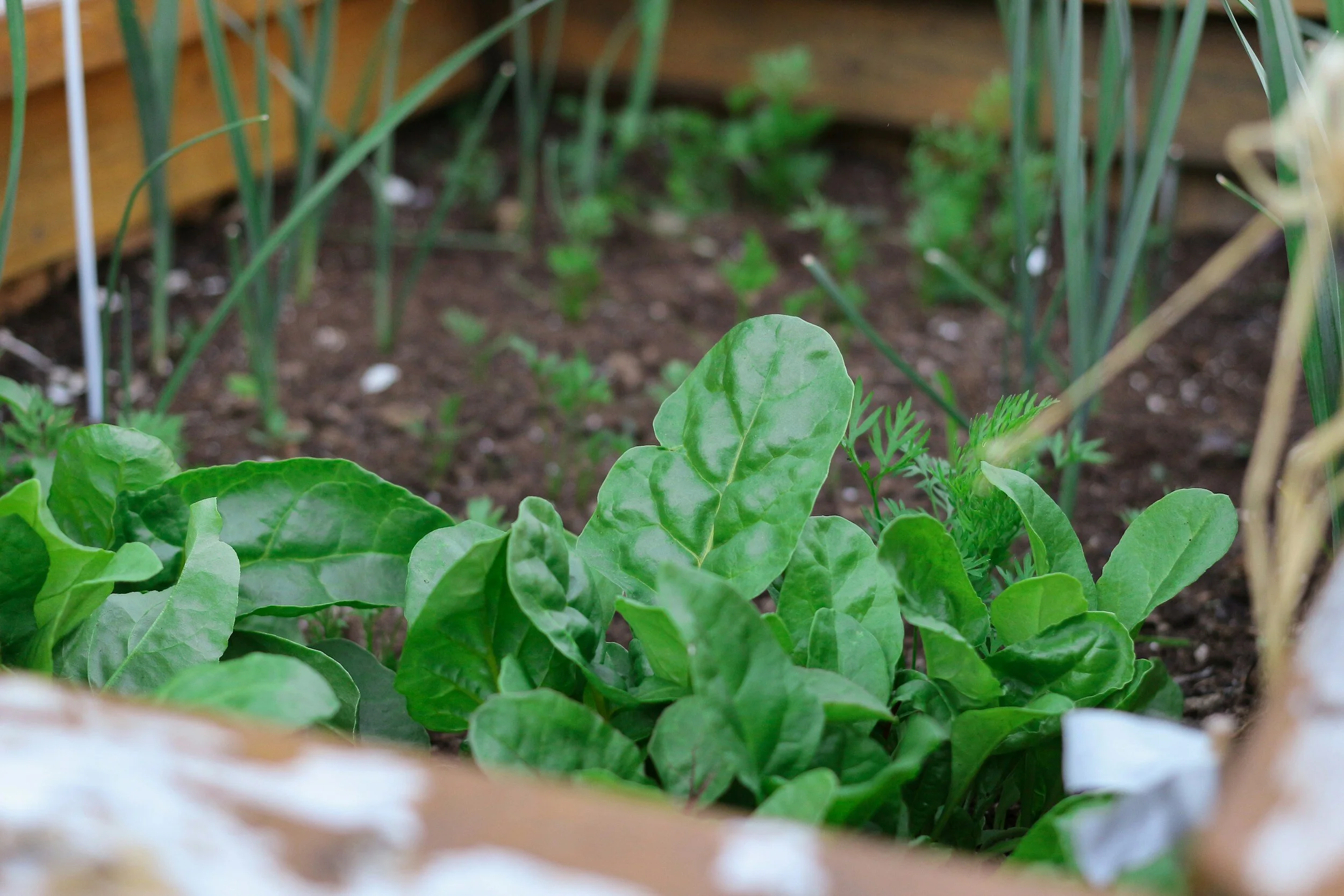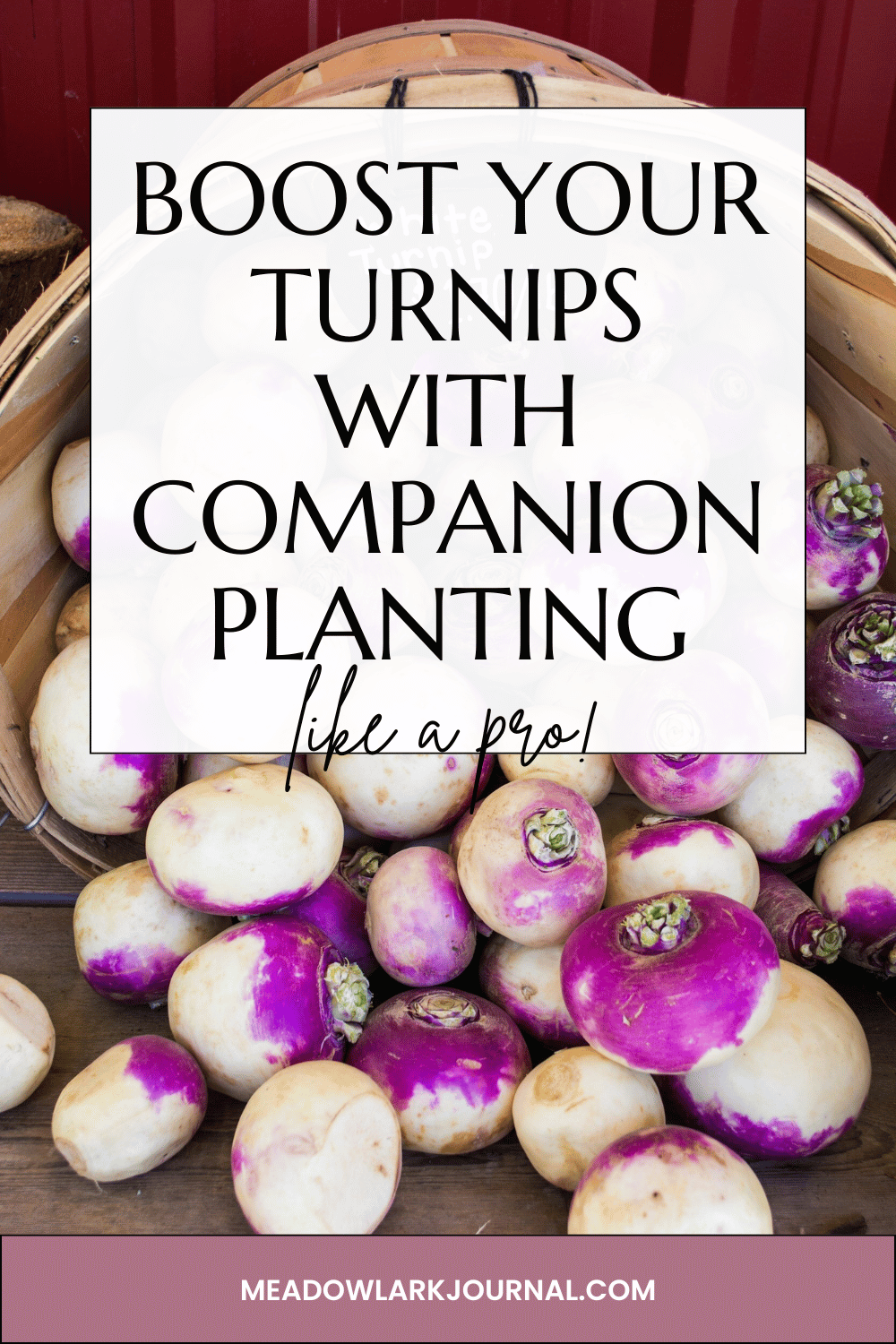Boost Your Turnips with Companion Planting
This website is reader-supported - thank you! This post may contain affiliate links. As an Amazon Associate, I earn from qualifying purchases at no extra cost to you.
Here we're focusing on a game-changing gardening technique: companion planting turnips.
This method is not just about growing turnips; it's about creating a thriving ecosystem in your backyard where turnips and their plant companions support each other for optimal growth.
Whether you're a seasoned gardener or a curious newbie, this guide is packed with insights and tips to help your turnips and their companions flourish together.
So, let's dive into the world of companion planting and discover how to make your turnip patch a beacon of garden harmony and productivity.
Want to learn more about companion planting?
Check out my guides:
Best Turnip Companion Plants
Turnips are quite the team players in the garden.
Pairing them with the right companions can lead to a bountiful and healthy harvest.
Here's a closer look at some of the top companion plants for turnips and the unique benefits they bring:
Peas and Beans: The Nitrogen Fixers
Why They're Great:
Both peas and beans are known as nitrogen-fixers.
They have a special ability to convert atmospheric nitrogen into a form that plants can absorb.
This process enriches the soil, providing turnips with the essential nitrogen they need for healthy growth.
Practical Tip:
Plant peas or beans a few weeks before sowing turnip seeds.
This allows them to start fixing nitrogen in time for the turnips to benefit.
Here are the peas I recommend growing:
Garlic and Onions: The Natural Protectors
Why They're Great:
These pungent plants are natural pest repellents.
Their strong odors deter common pests like aphids and root maggots, which can be a nuisance to turnips.
Practical Tip:
Intersperse garlic and onion plants around your turnip plot.
This creates a protective barrier, warding off pests with their strong scents.
Here are the onions I recommend growing:
Cabbage Family: The Complementary Neighbors
Why They're Great:
Members of the cabbage family, including Brussels sprouts, kale, and broccoli, share common pests with turnips.
Planting them together can confuse pests and reduce the overall damage to any one crop.
Practical Tip:
Alternate rows of turnips and cabbage family plants.
This intercropping strategy can effectively manage pests while optimizing space.
Here is the kale I recommend growing:
Leafy Greens: The Harmonious Companions
Why They're Great:
Leafy greens like Swiss chard, spinach, and lettuce don't compete heavily with turnips for nutrients.
They also have similar water and light requirements, making them harmonious companions.
Practical Tip:
Plant leafy greens in the spaces between turnip rows.
This maximizes garden space and creates a diverse growing environment.
Here is the lettuce I recommend growing:
Marigolds: The Colorful Guardians
Why They're Great:
Not only do marigolds add a splash of color to your garden, but they also repel nematodes and other soil pests that can harm turnips.
Practical Tip:
Plant marigolds around the perimeter of your turnip area.
Their bright flowers attract beneficial insects while deterring harmful ones.
Here are the marigolds I recommend growing:
Companion Planting as an Art
Remember, while these are some of the best companions for turnips, gardening is an ever-learning journey.
Feel free to experiment with these and other companions to see what works best in your unique garden environment.
Want to learn more about companion planting? Check out my guides:
Plants to Avoid Planting with Turnips
While companion planting can be a boon for turnips, it's equally important to know which plants could be detrimental to their growth.
Here are some plants you might want to keep at a distance from your turnips:
Root Crops
Why to Avoid:
Root crops like carrots and parsnips can compete with turnips for nutrients and space in the soil.
Since they have similar growth requirements and pest attractions, they can exacerbate issues like nutrient depletion and pest infestation.
Practical Tip:
If you're planning to grow multiple root crops, allocate separate areas in your garden to prevent competition.
Potatoes
Why to Avoid:
Potatoes and turnips can attract similar pests, such as root maggots and flea beetles.
Planting them together can lead to a higher concentration of these pests, which might cause more damage to both crops.
Practical Tip:
Keep a good distance between your potato and turnip plants, or plant them in alternate years in the same spot to reduce pest buildup.
Fennel
Why to Avoid:
Fennel is known to be allelopathic, meaning it releases substances that can inhibit the growth of other plants, including turnips.
Practical Tip:
Reserve a specific spot for fennel away from your main vegetable garden to prevent it from affecting the growth of turnips and other vegetables.
Mustard Greens
Why to Avoid:
Mustard greens can attract pests that also target turnips, leading to a higher risk of infestation and disease.
Practical Tip:
Plant mustard greens in a separate part of the garden or in a different season from your turnips.
Sunflowers
Why to Avoid:
Sunflowers can have an allelopathic effect, similar to fennel, and their large root systems can dominate the soil, leaving less room and nutrients for turnips to grow.
Practical Tip:
If you're growing sunflowers, ensure they're planted in a different area, as their shadow can also inhibit the growth of turnips.
Understanding Companion Planting Dynamics
The key to successful companion planting lies in understanding the unique interactions between different plants.
By knowing which plants to avoid near turnips, you can prevent potential issues and foster a more harmonious and productive garden.
The Magic of Companion Planting
Companion planting isn't just a trend in the gardening world; it's a tried-and-true method that goes back centuries.
It involves strategically placing different plants near each other so that they can mutually benefit from their respective traits.
But what makes it so magical, especially for turnips? Let's explore.
A Symphony of Benefits
When plants grow together in a well-planned companion planting scheme, they create a mini-ecosystem.
Here's how that magic happens:
Attracting Beneficial Insects:
Certain plants emit fragrances or possess traits that lure beneficial insects.
These friendly critters pollinate plants and prey on harmful pests.
For instance, flowering plants like marigolds can attract pollinators and beneficial bugs that keep turnip-damaging pests at bay.
Natural Pest Control:
Some plants, like garlic and onions, have strong scents that repel common pests.
Planting these near turnips acts as a natural pest deterrent, reducing the need for chemical pesticides.
Soil Health and Nutrient Sharing:
Different plants have different nutrient needs and contributions.
Legumes, such as peas, enrich the soil with nitrogen, a nutrient crucial for turnip growth.
This symbiotic relationship means healthier, more nutrient-dense soil.
Physical Support and Shade:
Taller plants can offer shade or support to smaller companions.
For turnips, this can mean protection from harsh sun or strong winds.
Trap Cropping:
This involves planting a crop that pests prefer more than turnips.
These 'sacrificial' plants act as a decoy, keeping pests away from your precious turnips.
Tailoring to Turnips
For turnips, the right companions can make a world of difference.
They can enhance growth, improve flavor, and increase yield. It's all about understanding what turnips need (like nitrogen-rich soil) and what they don't (like flea beetles).
By choosing companions that address these needs, you give your turnips the best chance to flourish. Companion planting is as much an art as it is a science.
It requires observation, experimentation, and a bit of garden intuition. But when done right, it's like conducting a beautiful symphony where every plant plays its part in harmony.
And the star of this symphony? Your thriving turnips!
Companion Planting Tips for Different Regions
Companion planting for turnips can vary significantly depending on regional climate, soil type, and local pest populations.
Here's how to tailor your companion planting strategy to suit different regions:
In Warm and Humid Climates (Like Florida)
Challenges:
High humidity can increase the risk of fungal diseases, and warmer temperatures might attract different pests.
Tips:
Choose companions that thrive in humid conditions, such as beans or southern peas, which can also improve soil nitrogen for turnips.
Incorporate plants like marigolds or nasturtiums, which can tolerate heat and deter pests common in warm climates.
Here are the southern peas I recommend growing:
In Cooler, Northern Climates
Challenges:
Shorter growing seasons and cooler temperatures.
Tips:
Opt for fast-maturing companions like lettuce or spinach, which can grow well alongside turnips in cooler temperatures.
Implement cold-hardy companions such as garlic, which can deter pests and withstand cooler climates.
Here is the spinach I recommend growing:
In Dry or Arid Regions
Challenges:
Water scarcity and intense sunlight.
Tips:
In Regions with Heavy Clay Soil
Challenges:
Poor drainage and compaction.
Tips:
Select companions like radishes or leafy greens, which can help break up the soil and improve its structure.
Amend the soil with organic matter to improve drainage and aeration.
Here are the radishes I recommend growing:
In Urban or Limited Space Gardens
Challenges:
Space constraints and possibly higher pollution levels.
Tips:
Utilize vertical companion planting, pairing turnips with climbing plants like peas.
Consider container gardening with turnips and small companions like herbs or flowers that can thrive in pots.
Companion Planting as a Regional Practice
Remember, the success of companion planting for turnips can greatly depend on adapting to your local environment.
Don't hesitate to experiment and adjust your companion planting strategy based on the unique conditions of your region.
Equip your urban green space with my recommend top tier tools.
Maximizing Your Harvest
Growing turnips in your garden can be highly rewarding, especially when you employ strategies to maximize their growth and yield.
Here are some advanced tips to help you get the most out of your turnip harvest:
Optimal Spacing for Healthy Growth
Spacing Needs:
Turnips need enough space to develop their roots.
Crowded conditions can lead to smaller turnips and increased susceptibility to disease.
Practical Tip:
Plant turnip seeds about 4-6 inches apart in rows spaced 12-18 inches apart.
This gives each turnip plant enough room to grow while allowing you to walk between rows for easy maintenance.
Soil Preparation and Maintenance
Soil Health:
Turnips prefer well-drained soil rich in organic matter.
Good soil structure supports healthy root development.
Practical Tip:
Before planting, incorporate compost or aged manure into the soil.
This not only adds nutrients but also improves soil texture and drainage.
Here is the organic compost I recommend for turnips:
Watering Techniques
Consistent Moisture:
Turnips require consistent moisture, especially during the early stages of growth and root development.
Practical Tip:
Water your turnips regularly, aiming for about an inch of water per week.
For more watering tips, check out my guide How to Use Watering Globes.
Use mulch around the plants to retain moisture and regulate soil temperature.
Here is the mulch I recommend:
Fertilization for Optimal Growth
Nutrient Needs:
While turnips aren't heavy feeders, they do benefit from balanced nutrition.
Practical Tip:
Apply a balanced, all-purpose organic fertilizer at planting and midway through the growing season to support healthy growth.
Here is the fertilizer I recommend:
Pest and Disease Management
Preventive Measures:
Regularly inspect your turnips and companion plants for signs of pests and diseases.
Practical Tip:
Employ organic pest control methods when necessary, such as introducing beneficial insects or using organic insecticidal soaps.
Rotate crops each year to prevent disease buildup in the soil.
Harvesting at the Right Time
Harvest Timing:
Turnips can be harvested when they are of suitable size but not overly large, as they can become woody.
Practical Tip:
Start checking turnips for harvest when they are about 2-3 inches in diameter.
The greens can also be harvested and are most tender when young.
Pin this post to save it for later!
















































